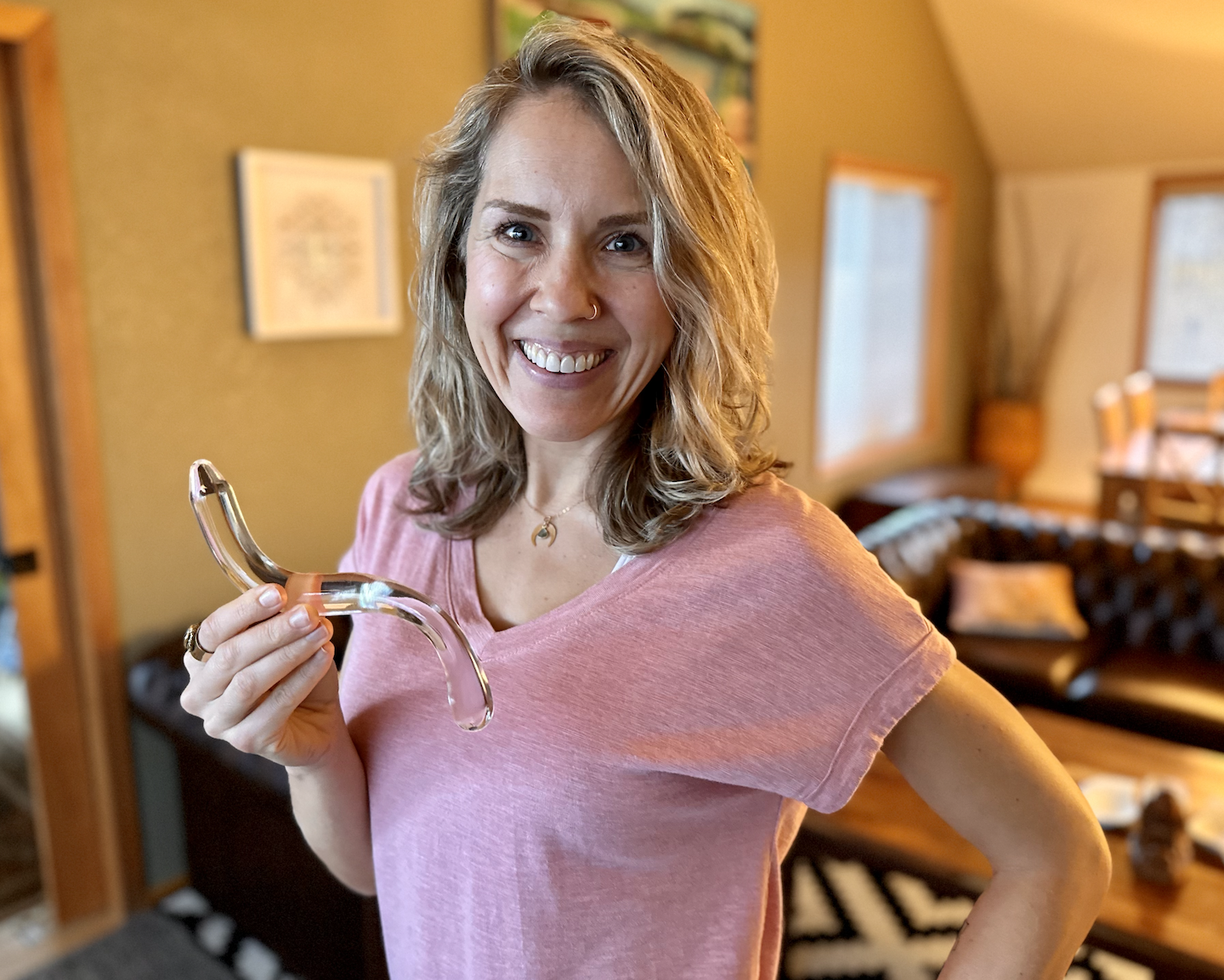Using Dilators and Wands for Pelvic Tension and Pain Relief

In the interest of continuing to demystify the female pelvis and breaking taboos surrounding the vulva and vagina, let’s talk about internal pelvic floor relaxation! If you’re familiar with my work and/or you’ve been to pelvic floor physical therapy, you’ve probably worked on learning how to relax your pelvic floor. If you haven’t been to PT, but you know you have a tense pelvic floor (pro tip: most of us do!) and you’d like to start healing, my 12-week online program Overcome Pelvic Pain for Women may be just what you’re looking for.
But did you know that you can also use dilators and wands for pelvic tension and pain relief?
I always recommend learning what’s best FOR YOU from a skilled pelvic floor physical therapist, but here are some ideas to help get you started.
Dilators and wands: what’s the difference?
Dilators usually come in sets of three to five (or more); they are dildo-like insertables in graduating sizes used to help relax the vaginal canal (for penetrative sex, a pelvic exam, etc). Wands, however, are usually curved tools used to help find trigger points in the pelvic floor. By applying some pressure and breathing deeply, they can help you release those painful knots.

Both wands and dilators come in a variety of materials (most commonly glass, plastic, or medical-grade silicone). No one material is better than another—it all depends on personal preference and what kind of lubricant you like to use. (Read til the end to learn more about this!)
A quick dilator how-to
Note: do not use pelvic wands or dilators on tissue that has undergone radiation treatment. If you have any questions, concerns, or difficulties, please consult a pelvic floor physical therapist in your area.
Make sure you’re in a comfortable space and you won’t be interrupted. You want to be as relaxed as possible.
- Start with a size that doesn’t feel intimidating (and remember that you don’t have to graduate up to any sizes that you don’t want to!).
- Apply lubricant to the dilator and gently insert it into the vaginal canal.
- If this feels like too much, just start with the tip. Let your body get used to the sensation of the material.
Remember, YOU are in total control!
- Breathe deeply and once the dilator is fully inserted, relax. The idea is for your body to get used to something being inside and it NOT hurting.
- Rest like this for 5-10 minutes and then either call it a day or move up to the next size if you feel ready. You’ll know you’re ready for the next size up when you are able to comfortably insert the dilator with no pain.
This process helps your body remember (or learn) what it is like to have something inside comfortably. It may even remind your body that it is capable of feeling pleasure! Know that if you are able to easily insert a dilator by yourself with no pain even ONCE, it’s possible to do it again!
This practice can even prepare you and ease any anxiety you may have around pelvic exams or sexual intercourse.
Using a wand
This process is very similar to using dilators in that you want to be comfortable and RELAXED. Wands are curved so you can reach trigger points yourself. Sometimes they are deeper in our pelvic floors than our fingers are able to reach and they may be at hard-to-reach angles. You may know where to look for your trigger points if you’re in pelvic floor PT, but if not…
- Slowly move the wand around inside, applying a little bit of pressure here and there. If you find a tender spot, gently press the tip of the wand into that spot.
- Avoid pressing the wand upward (toward the pubic bone) since that's the area of your urethra, and it can create sensations of urinary urgency.
- Take several deep breaths and see if you can feel that tension melting. IMAGINE it melting away and releasing. Visualization is really helpful! Try my Mental Massage Guided Meditation:
Even if you can’t feel a difference, taking the time to relax and do some deep breathing is so good for your mind, body, and spirit.
- Adjust the wand, find another spot, and repeat.
Here's a video with a step-by-step tutorial about how I use my pelvic wand, including exactly HOW and WHERE I press to release tension and tender points!
What about intrarectal (anal) stretching?
See an example of a (larger) wand in the following video, and learn how to safely experiment with intrarectal stretching. People of any gender can do anal stretching!
The next steps on your journey
This is just a brief guide to using dilators and wands to help with pelvic tension and pain relief. You may even have some questions! If so…
Watch my interview with a sex educator
Here, we discuss dilators, pleasure, and pelvic tension and pain relief (learn more about materials and lubricants here, too)!
Find the extra support you need
Dilators and wands can be great supplemental and supportive tools for pelvic floor healing, especially when it comes to facilitating more comfortable penetrative sex. Even if being sexually active isn’t in your goals, dilators and wands can help with pelvic tension and pain relief in general.
And if you think a self-guided program for pelvic tension and pain relief is what you need, check out Overcome Pelvic Pain for Women!
Does your pelvic floor need help?
Many women think they just need live with the changes they’re experiencing
“down there,” but this is NOT the case. Take the short quiz to find out if you have issues that can be solved naturally.








